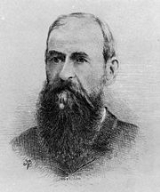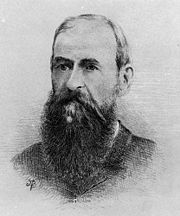
Thomas Pennington Lucas
Encyclopedia
Thomas Pennington Lucas was a Scottish
-born Australia
n medical practitioner, naturalist
, author, philosopher and utopianist
.

, Scotland
to Samuel Lucas, a Wesleyan Methodist minister, and Elizabeth Broadhurst. Lucas inherited from his father a love of natural history and a life-long determination to reconcile his strong religious beliefs with his scientific convictions, as evidenced in many of his books. Because his father was often on the move to new postings, taking his family with him, Thomas was educated at King Edward VI Grammar School
at Stratford-on-Avon, Helston Grammar School, Cornwall, and New Kingswood School
in Bath.
, in 1876 Thomas Lucas migrated to Melbourne
, Australia where he set up a medical practice. His three living children joined him there in 1879 after being cared for by his brother, Arthur Henry Shakespeare Lucas
. Arthur followed him to Melbourne in 1883 and became a well known biologist and schoolmaster in his own right.
Lucas and his family moved to Brisbane
, Queensland in 1886. His medical practice was first set up in central Brisbane, moving in the early 1890s to South Brisbane
. Later he relocated to Acacia Ridge
south of Brisbane, then finally to New Farm in inner north Brisbane from 1911 until Lucas's death.
A firm believer in the medicinal properties of pawpaws
, he developed and marketed Lucas' Papaw Ointment, which is still produced by Lucas's descendants from a location at Beaudesert Road, Acacia Ridge.
. During his lifetime he collected a large number of butterfly and moth specimens, some of which eventually found their way into the possession of the South Australian Museum
.
Lucas was a member of various learned societies including the Linnean Society
, the Royal Society
, the Royal College of Surgeons
, and the British Medical Association
in England; and the Linnean Society of New South Wales
, the Royal Society of Queensland
, and the Natural History Society of Queensland.
Scotland
Scotland is a country that is part of the United Kingdom. Occupying the northern third of the island of Great Britain, it shares a border with England to the south and is bounded by the North Sea to the east, the Atlantic Ocean to the north and west, and the North Channel and Irish Sea to the...
-born Australia
Australia
Australia , officially the Commonwealth of Australia, is a country in the Southern Hemisphere comprising the mainland of the Australian continent, the island of Tasmania, and numerous smaller islands in the Indian and Pacific Oceans. It is the world's sixth-largest country by total area...
n medical practitioner, naturalist
Natural history
Natural history is the scientific research of plants or animals, leaning more towards observational rather than experimental methods of study, and encompasses more research published in magazines than in academic journals. Grouped among the natural sciences, natural history is the systematic study...
, author, philosopher and utopianist
Utopia
Utopia is an ideal community or society possessing a perfect socio-politico-legal system. The word was imported from Greek by Sir Thomas More for his 1516 book Utopia, describing a fictional island in the Atlantic Ocean. The term has been used to describe both intentional communities that attempt...
.

Early life
Lucas was born in DunbarDunbar
Dunbar is a town in East Lothian on the southeast coast of Scotland, approximately 28 miles east of Edinburgh and 28 miles from the English Border at Berwick-upon-Tweed....
, Scotland
Scotland
Scotland is a country that is part of the United Kingdom. Occupying the northern third of the island of Great Britain, it shares a border with England to the south and is bounded by the North Sea to the east, the Atlantic Ocean to the north and west, and the North Channel and Irish Sea to the...
to Samuel Lucas, a Wesleyan Methodist minister, and Elizabeth Broadhurst. Lucas inherited from his father a love of natural history and a life-long determination to reconcile his strong religious beliefs with his scientific convictions, as evidenced in many of his books. Because his father was often on the move to new postings, taking his family with him, Thomas was educated at King Edward VI Grammar School
King Edward VI School Stratford-upon-Avon
King Edward VI School is a voluntary aided boys grammar school in Stratford-upon-Avon, Warwickshire, England...
at Stratford-on-Avon, Helston Grammar School, Cornwall, and New Kingswood School
Kingswood School
Kingswood School, referred to as 'Kingswood', is an independent day and boarding school located in Bath, Somerset, England. The school is coeducational and educates some 950 children aged 3 to 18. It is notable for being founded by John Wesley, the founder of Methodism, in 1748...
in Bath.
Move to Australia
Having developed tuberculosisTuberculosis
Tuberculosis, MTB, or TB is a common, and in many cases lethal, infectious disease caused by various strains of mycobacteria, usually Mycobacterium tuberculosis. Tuberculosis usually attacks the lungs but can also affect other parts of the body...
, in 1876 Thomas Lucas migrated to Melbourne
Melbourne
Melbourne is the capital and most populous city in the state of Victoria, and the second most populous city in Australia. The Melbourne City Centre is the hub of the greater metropolitan area and the Census statistical division—of which "Melbourne" is the common name. As of June 2009, the greater...
, Australia where he set up a medical practice. His three living children joined him there in 1879 after being cared for by his brother, Arthur Henry Shakespeare Lucas
Arthur Henry Shakespeare Lucas
Arthur Henry Shakespeare Lucas was an English-born Australian schoolmaster and scientist.-Early life:Lucas born was born in Stratford-on-Avon, Warwickshire, the third son of the Rev. Samuel Lucas, a Wesleyan minister, and his wife Elizabeth, née Broadhead...
. Arthur followed him to Melbourne in 1883 and became a well known biologist and schoolmaster in his own right.
Lucas and his family moved to Brisbane
Brisbane
Brisbane is the capital and most populous city in the Australian state of Queensland and the third most populous city in Australia. Brisbane's metropolitan area has a population of over 2 million, and the South East Queensland urban conurbation, centred around Brisbane, encompasses a population of...
, Queensland in 1886. His medical practice was first set up in central Brisbane, moving in the early 1890s to South Brisbane
South Brisbane, Queensland
South Brisbane is an inner city suburb of Brisbane, Australia located on the southern bank of the Brisbane River, directly connected to the central business district by the Kurilpa, Victoria and Goodwill bridges....
. Later he relocated to Acacia Ridge
Acacia Ridge, Queensland
Acacia Ridge is a suburb of Brisbane, Queensland, Australia. Acacia Ridge is south of the central business district. The population in the 2001 census was 6648....
south of Brisbane, then finally to New Farm in inner north Brisbane from 1911 until Lucas's death.
A firm believer in the medicinal properties of pawpaws
Papaya
The papaya , papaw, or pawpaw is the fruit of the plant Carica papaya, the sole species in the genus Carica of the plant family Caricaceae...
, he developed and marketed Lucas' Papaw Ointment, which is still produced by Lucas's descendants from a location at Beaudesert Road, Acacia Ridge.
Scientist
In 1882 Thomas Lucas founded the Field Naturalists Club of VictoriaField Naturalists Club of Victoria
The Field Naturalists Club of Victoria is an Australian natural history and conservation organisation.It was founded in May 1880 by a group of nature enthusiasts that included Thomas Pennington Lucas. Charles French and Dudley Best. It is the oldest conservation group in Victoria...
. During his lifetime he collected a large number of butterfly and moth specimens, some of which eventually found their way into the possession of the South Australian Museum
South Australian Museum
The South Australian Museum is a museum in Adelaide, South Australia, founded in 1856. It occupies a complex of buildings on North Terrace in the cultural precinct of the Adelaide Parklands.-History:...
.
Lucas was a member of various learned societies including the Linnean Society
Linnean Society of London
The Linnean Society of London is the world's premier society for the study and dissemination of taxonomy and natural history. It publishes a zoological journal, as well as botanical and biological journals...
, the Royal Society
Royal Society
The Royal Society of London for Improving Natural Knowledge, known simply as the Royal Society, is a learned society for science, and is possibly the oldest such society in existence. Founded in November 1660, it was granted a Royal Charter by King Charles II as the "Royal Society of London"...
, the Royal College of Surgeons
Royal College of Surgeons of England
The Royal College of Surgeons of England is an independent professional body and registered charity committed to promoting and advancing the highest standards of surgical care for patients, regulating surgery, including dentistry, in England and Wales...
, and the British Medical Association
British Medical Association
The British Medical Association is the professional association and registered trade union for doctors in the United Kingdom. The association does not regulate or certify doctors, a responsibility which lies with the General Medical Council. The association’s headquarters are located in BMA House,...
in England; and the Linnean Society of New South Wales
Linnean Society of New South Wales
The Linnean Society of New South Wales promotes the Cultivation and Study of the Science of Natural History in all its Branches and was founded in Sydney, New South Wales in 1874 and incorporated in 1884. It succeeded the Entomological Society of New South Wales, founded in 1862 and folded in...
, the Royal Society of Queensland
Royal Society of Queensland
The Royal Society of Queensland was formed in Queensland, Australia in 1884, with royal patronage granted in 1885.The aim of the Society is "Increasing awareness of natural sciences in Queensland"....
, and the Natural History Society of Queensland.
Author
Thomas Lucas published a number of books during his lifetime, mostly on non-fiction topics. Some however were works of fiction; they include The Curse and its Cure, comprising two novels bound and published together in 1894, The Ruins of Brisbane in the Year 2000 and Brisbane Rebuilt in the Year 2200. These novels are believed to be the first to be published anywhere that use Brisbane as their setting.Personal life
Lucas was married three times:- to Mary Frances Davies from 1868 until her death in 1875 at age 30. They had six children, of whom three survived: Thomas Pennington (born 1869), Arthur Henry (1871) and Celia Juliana (1874);
- to Mary Bradbury Ironside from 1878 until her death in 1888. She too bore six children, of whom only one, Eunice Sarah (born 1886), survived beyond infancy;
- to Susan Draper from 1889 until Thomas's death. They had no children.

